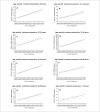Trends in colorectal cancer in Iraq over two decades: incidence, mortality, topography and morphology
- PMID: 35933610
- PMCID: PMC9357297
- DOI: 10.5144/0256-4947.2022.252
Trends in colorectal cancer in Iraq over two decades: incidence, mortality, topography and morphology
Abstract
Background: Colorectal cancer (CRC) is mainly a disease of the elderly in the Western world, but its characteristics are changing globally. Iraq does not have a well established CRC screening program. Understanding trends of CRC incidence, fatality and the clinical features of CRC patients is vital to the design of effective public health measures; public awareness, screening, diagnosis and treatment strategies to meet the future demands.
Objectives: Determine trends in demography, incidence proportion, mortality, topography (primary tumor site) and morphology (histology) over two decades.
Design: Registry-based study SETTING: Iraqi National Cancer Registry (INCR) database PATIENTS AND METHODS: We collected and analyzed data from CRC patients obtained from the INCR to calculate incidence and mortality proportion per 100 000 population for the period from 2000 to 2019. In addition to estimation, data were examined by anatomic location and morphological type.
Main outcome measures: Change in the incidence and mortality proportion, topography and morphology of CRC over 20 years.
Sample size: 20 880 CRC patients ranging in age from 14-80 years.
Results: The overall (males and females) CRC incidence proportion (CIP) increased from 2.28 to 6.18 per 100 000 population in 2000 and 2019, respectively, with an annual percentage change (APC) of 5.11%. The incidence proportion (IP) of CRC in patients from 20 to <50 years rose from 1.46 in 2000 to 4.36 per 100 000 population in 2019, which is an APC of 5.6%. The IP in patients older than 50 years rose from 12.7 to 40.59 per 100 000 population in 2000 and 2019, respectively, with an APC of 5.98%. The percentage of all CRC cases to all total malignancies in Iraq grew from 3.69% in 2000 to 6.5% in 2019. The CRC mortality proportion increased from 1.25 to 1.77 per 100 000 populations in 2010 and 2019, respectively, reflecting an APC of 3.54%. Anatomically, colon (C18) tumor represented 59.2% and 65.7% in 2000 and 2019, respectively. Rectal (C20) tumors were 37.2% in 2000 down to 31.4% in 2019, while rectosigmoid junction tumor (C19) were 3.6% in 2000 dropping to 2% in 2019.
Conclusions: CRC in Iraq is still a disease of the elderly and is rising in incidence and mortality in all age groups. This necessitates reconsidering health policy regarding CRC; public awareness, screening and management strategies to accommodate for these alarming changes.
Limitations: Data about stages, grades and molecular characterisations are not available in the INCR.
Conflict of interest: None.
Figures







References
-
- Siegel RL, Miller KD, Fuchs HE, Jemal A. Cancer Statistics, 2021. CA Cancer J Clin. 2021;71(1):7–33. - PubMed
-
- Sung H, Ferlay J, Siegel RL, Laversanne M, Soerjomataram I, Jemal A, et al. . Global Cancer Statistics 2020: GLOBOCAN Estimates of Incidence and Mortality Worldwide for 36 Cancers in 185 Countries. CA: A Cancer Journal for Clinicians. 2021;71(3):209–49. - PubMed
-
- Bray F, Ferlay J, Soerjomataram I, Siegel RL, Torre LA, Jemal A. Global cancer statistics 2018: GLOBOCAN estimates of incidence and mortality worldwide for 36 cancers in 185 countries. CA: A Cancer Journal for Clinicians. 2018;68(6):394–424. - PubMed
MeSH terms
LinkOut - more resources
Full Text Sources
Medical
Research Materials

